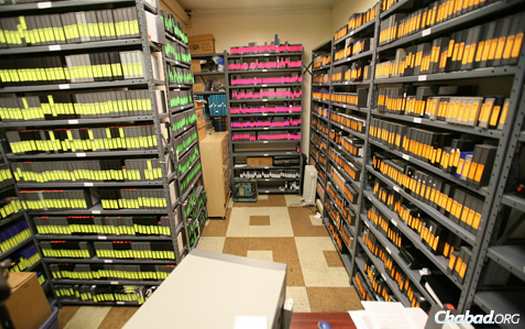
500th Weekly Edition of ‘Living Torah’ a Milestone
On a crisp September morning in 2001, terrorists hijacked and slammed two airplanes into the World Trade Center’s twin towers in Lower Manhattan. (Another plane rammed into the Pentagon just outside Washington, D.C.; and a fourth crashed onto a swath of empty land outside Pittsburgh, Pa.).
Just miles away, in an office in Lubavitch World Headquarters in the Crown Heights neighborhood of Brooklyn, N.Y., Rabbi Elkana Shmotkin, executive director of JEM (Jewish Education Media), was hard at work on an exciting new project: a yearlong series of weekly VHS videos featuring talks and selected inspirational moments from the Rebbe, Rabbi Menachem M. Schneerson, of righteous memory.
Just as he and his team were mastering the first video, he heard the news—and saw the smoke.
The new project—called “Living Torah”—quickly became a weekly fixture in homes, synagogues, schools and even prisons all over the world. It also served as the rabbi’s personal response to the destruction he witnessed on that day. One year later, he knew there was no way he would be able to stop the project.
“It’s become something that people live with every week,” he explains. “People who’ve never had the merit to meet the Rebbe in person tell me how the videos literally bring the Rebbe and his teachings to life for them.”
In its original format, the weekly “Living Torah” featured four parts: an excerpt from a farbrengen (public address) of the Rebbe; “Eye to Eye,” a private conversation with the Rebbe often held during the Sunday “dollars distribution; “Timeless Moments,” which showed the Rebbe during prayer or other moments of devotion; and “Soul Strings,” which often featured the Rebbe leading Chassidim in heartfelt singing.
In 2004, the project shifted from VHS to DVD. Now, nearly a decade after the switch to DVD, the rabbi and his staff are poised to release the 500th weekly DVD edition.
Behind the Scenes
In 2006, the fourth section was replaced by a popular feature, “My Encounter”—those who recall personal interactions they’ve had with the Rebbe, going back all the way to the 1930s. These clips are culled from 1,000 videotaped interviews conducted by JEM’s “My Encounter” teams in Israel and the United States, which travel the world documenting the Rebbe’s life and extensive reach via the words of those he touched.
Other significant changes took place along the way. Rabbi Mendel Gourarie, who has worked on the project in a variety of positions, says some of the most noteworthy changes were made behind the scenes.
Through the Living Archive Preservation Project, the JEM team has amassed and digitized a colossal, virtual treasure trove of audio and video recordings, in addition to photographs, of the Rebbe. This allows them to peruse and select content for the weekly features in a fraction of the time it would have once taken using film and paper.
More than just preserving and categorizing the footage, the digitization project allows technicians to restore old films (many of which had turned brittle with age) to their original vibrancy and crispness.
As time passes, Gourarie concedes that the team is challenged to find appropriate material to highlight without repeating old features. “Every few years,” he acknowledges, “we worry that we’re soon going to run out of videos. But it seems like there’s a never-ending fountain. We know that people rely on us for their weekly dose of Torah inspiration, and it’s our obligation to provide it, so we persevere.”
One creative innovation has been to match up audio-only recordings from early pre-video farbrengens with period photographs of similar gatherings to create a video-like experience. These photos have been matched up with poor-quality video to provide enhanced visuals.
In addition to hundreds of DVDs sent regularly to six continents, the “Living Torah” is available on Chabad.org’s theRebbe.org and on a mobile app released in 2013, where thousands of people log on for inspiration and learning.
Rabbi Yitzchok Tsap, who directs the project, says unofficial polls have revealed that “Living Torah” may be viewed by as many as 200,000 people a week. “In addition to private homes, ‘Living Torah’ is played in Chabad Houses, synagogues, Jewish community centers, so we really have no way of knowing just how far it reaches,” he adds.
He reports that the app has allowed relevant “Living Torah” content to be shown to a whole new audience: “In addition to the current ‘Living Torah’ and 2,000 archival clips from past weeks, the app allows us to easily feature talks of the Rebbe as their topics come up in the news.”
The videos—with subtitles in Hebrew, English, French, Russian, Spanish, Hungarian and Yiddish, as well as child-friendly English and Hebrew voiceovers—are geared to reach far beyond the Chassidic community.
Typical feedback includes the following email shared by Rabbi Menachem Katz, director of prison and military outreach at the Florida-based Aleph Institute—a national organization that provides religious, educational, humanitarian and social services to individuals in institutional environments—from a member of the U.S. Armed Forces:
“[When I hear] the Rebbe speak through Living Torah videos … I become so overcome by emotion that I cry tears of not sadness, but joy. I know it may seem so odd for one not raised in a household of Chabad, and having not even truly being exposed to the Rebbe until I was 22, to feel so strongly in this way, but nonetheless I do. The Rebbe has been my inspiration through my training and during the hard times. During ruck marches and intense training, I would envision the face of the Rebbe and his teachings, and they would energize me deep from within.”













